The Community Super Block

Tibbalds
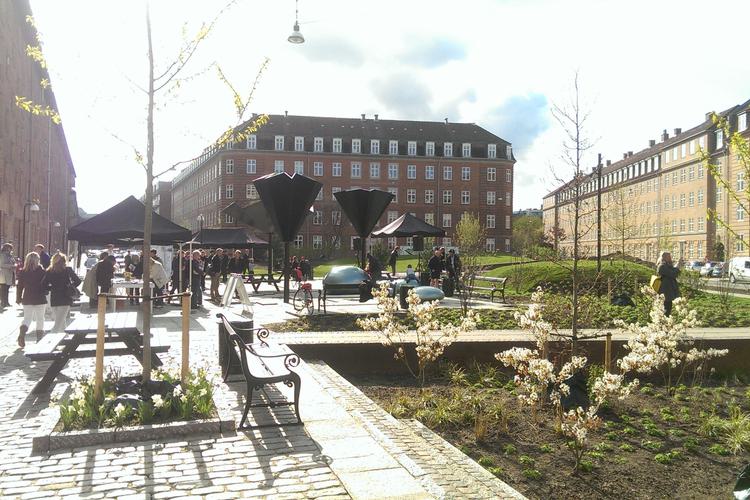
Tibbalds’ Senior Urban Designer Evelyn Wong has been inspired by the lockdown to develop an idea for creating ‘community super blocks’. Evelyn initially presented this idea as part of the NLA’s #BuildBackBetter series ‘Future streets in a post-pandemic London’ on June 18th, 2020.
At the start of lockdown, there was a very noticeable difference in our neighbourhoods. The birdsong was more audible and streets were a lot quieter. When out and about, I would always come across a least half a dozen people walking or running, but the vehicular traffic had almost all but disappeared. When I did come across a moving car, however, they always seemed to be moving far too quickly than what seemed necessary.
It may have been that they were only moving relatively fast for the new pace of lockdown life, but the fact that they seemed to barely slow for pedestrians – despite there being so many more of us – made me wonder: did that car really need to travel down this street? Or was it just a convenient shortcut enabled by our extensive, well-connected road network?
As I started to grow frustrated with the cars as lockdown continued, it made me think of the Barcelona ‘super block’. In 2016, Barcelona laid out the proposals to create mini traffic-free neighbourhoods bordered by roads where traffic would continue to flow, and the streets within would be repurposed for public life. The innovative proposals were a response to excessive pollution and noise levels, as well as a high number of road accidents, sedentary lifestyles and a general lack of green spaces – but the principle of reclaiming space back from cars and for people resonated.
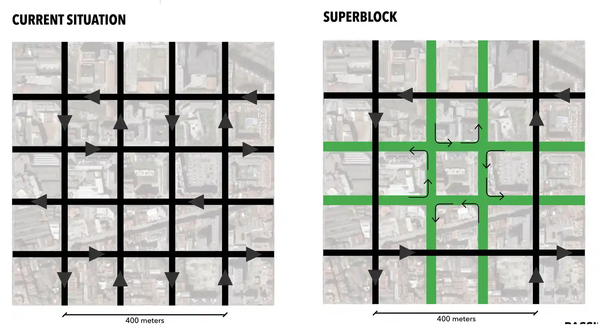
The Superblock concept originally conceived for Barcelona where black routes are for all transport, and green routes are for residents only, at a lowered speed, to prioritise pedestrians and cyclists. Image source: BCNecologia
With a number of superblocks now implemented in Barcelona, the response has been positive. More than half of residents in these areas are now walking as their primary mode of transportation, and there has also been an increase in cycle use. Studies estimate that if implemented city-wide, it would capture up to 70% of street space for bikes and pedestrians and could save 667 premature deaths per year from improvements to air quality, reduced noise, increase in physical activity, more green spaces, and improved microclimates.
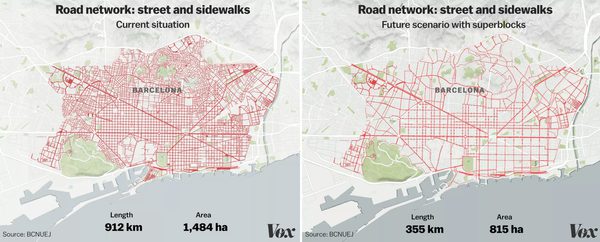
Superblocks could reclaim up to 70% of street space for public life. Image source: Vox.com
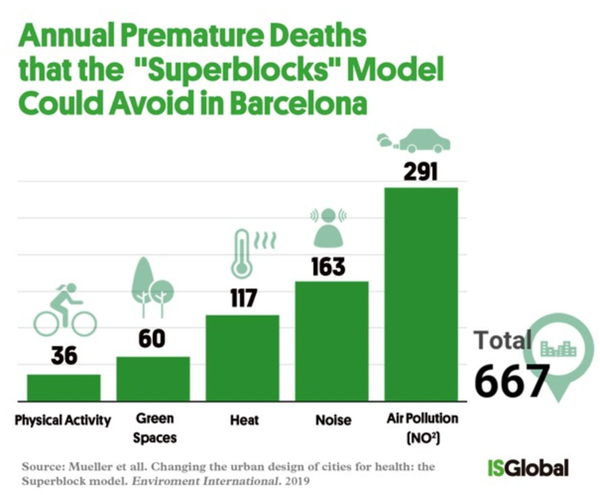
Projected number of premature deaths that could be avoided from implementing superblocks in Barcelona. Image source: IsGlobal
When I first came across the ‘super block’ concept, I thought it made so much sense as a general principle to limit the number of roads which cars could freely use as thoroughfares. So in my frustration with cars disrupting the peaceful streets that had come to be within my neighbourhood, I wondered, could the ‘super block’ be realised in London to help give space back to pedestrians, cyclists and social activity?
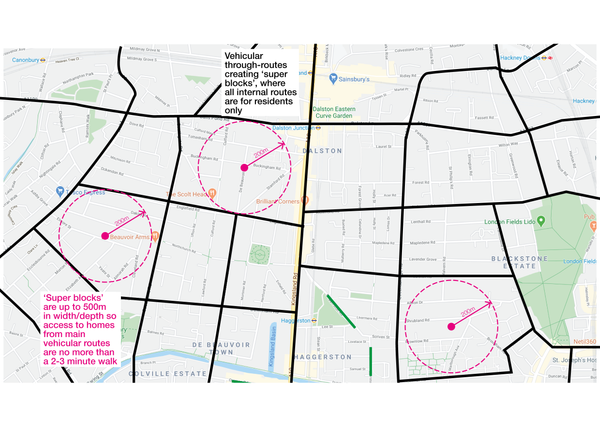
Testing out the superblock principles across an area of Hackney
I set out the principles on my local neighbourhood in Hackney using a Google Map screenshot. To ensure that no home was more than 250m, or 2-3min walk, from the perimeter roads, I set out a general rule that blocks should be no bigger than 500m in width and depth. Perimeter routes were also assigned where they contributed to a semi-regular grid and where they were already key roads designed to take a reasonable amount of traffic.
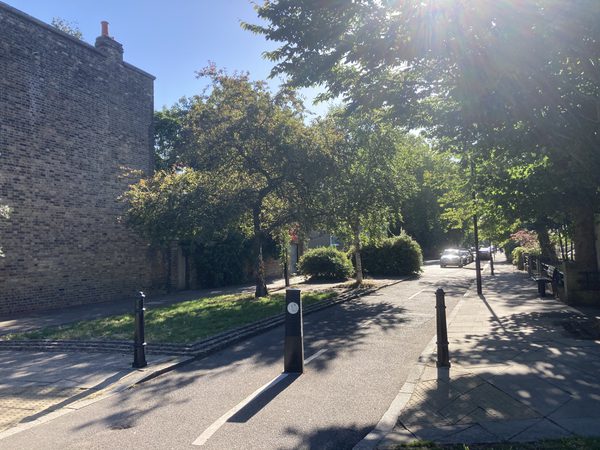
Bollards are used to block vehicular through-traffic along some streets within Hackney already
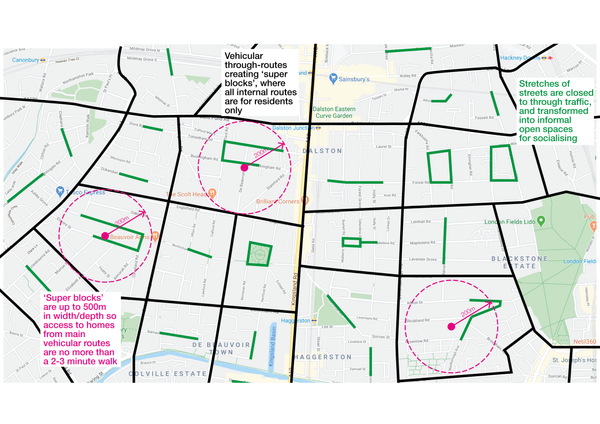
Green lines suggest where streets could be transformed into a non-trafficable open space dedicated to the immediate community
To close the super blocks down to traffic, I thought it needed to be more than just bollards, which are already used on a number of streets in the area to help prioritise cycle and pedestrian movement. It needed to go one step further. One step further to create a positive environment for the neighbourhood, achieved by transforming a stretch of street, or streets, into an inviting social open space where people could play, sit out, and meet their neighbours. Play streets jumped to mind immediately. This way, instead of using typical road infrastructure language, traffic would be disrupted by positive human activity, and a ‘community super block’ could be created.
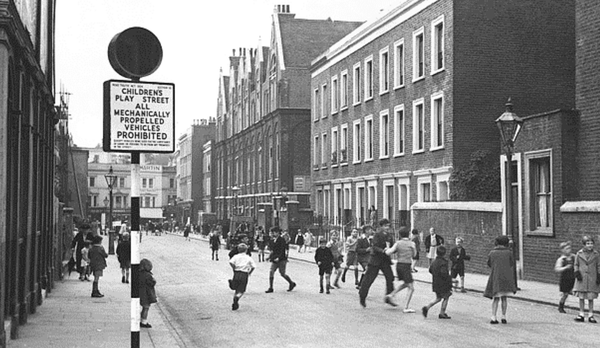
In the 1950s, there were 700 dedicated play streets across England and Wales. These all but disappeared by the 1980s however the last 10-15 years has seen a resurgence. Image source: London Play
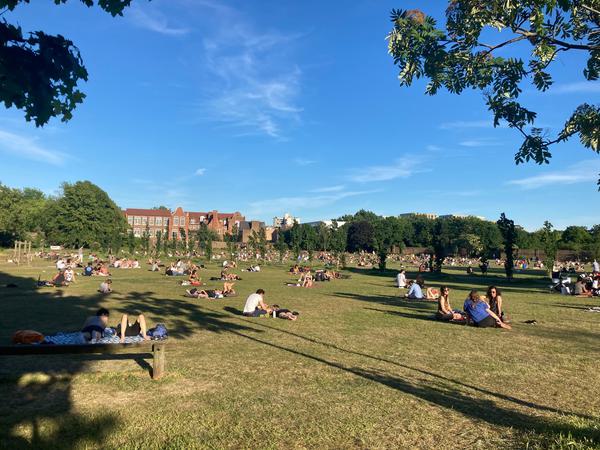
Haggerston Park during May 2020
Seeing the local parks swell with people on all but our greyest weather days, there certainly appears to be a clear appetite for more space to be dedicated to social interaction or simply relaxing outdoors and in the sun. While the push for more space for footpaths and cycleways is entirely necessary, more areas to be able to sit out comfortably – and safely – should also be demanded. With so many people living without access to private open space, including flatshares and families, that in lieu of upgrading entire apartment and flat blocks, more public open spaces need to be a priority.
The ‘community super block’ draws on similar principles as the Low Traffic Neighbourhoods initiative by Living Streets and London Cycling, which in turn references the ‘mini Holland’ concept. As with the community super block, the concept limits traffic to the perimeter and therefore frees up road space for pedestrians and cyclists to move much more freely and safely. As a relatively well-established initiative, we can glean some of the positive results from implemented Low Traffic Neighbourhoods schemes to indicate the success of such interventions. For example, the first Low Traffic Neighbourhood in Waltham Forest saw vehicular travel levels fall by over half inside the residential area and by 16% when including the main roads.
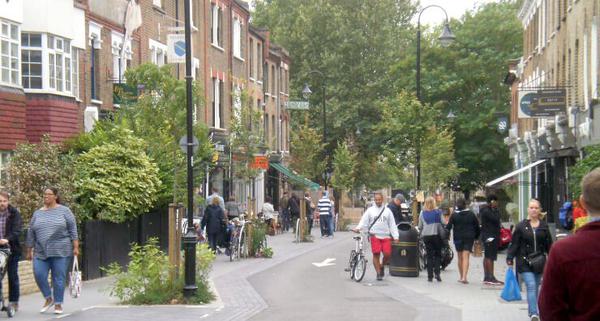
Orford Road, Walthamstow used to be a typical traffic-clogged high street prior to it being transformed to a Low Traffic Neighbourhood. Image source: London Living Streets
In addition to reducing traffic and enhancing the pedestrian and cyclist network, community superblocks have the potential to benefit the health and wellbeing of residents, to increase biodiversity and climate resilience, and improve safety within our neighbourhoods.
- Air quality would be improved from less through traffic
- Planting trees and planting within the community open space can help to clean the air, improving air quality, and provide habitat for biodiversity
- More residents would be inclined to walk and cycle for their daily journeys
- Residents would have a space nearby their home to occupy if in need of fresh air or company, particularly for those without access to private open space
- Children would be able to meet and play within a safe non-trafficable area
- SuDS could be incorporated within the community open space to assist with surface water drainage
- Trees planted alongside seating would provide shaded outdoor areas, providing relief from our homes which become overheated in the height of summer, and effectively reducing the urban heat island effect generally
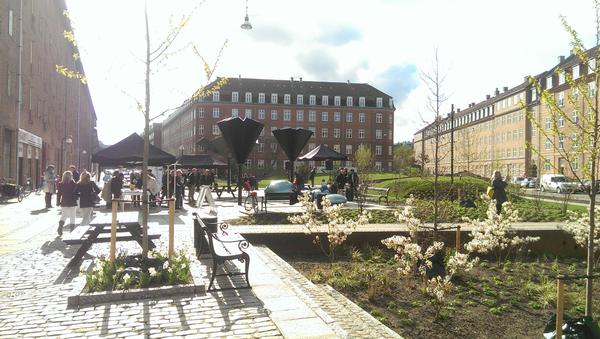
Østerbro in Copenhagen has incorporated green infrastructure as a more cost-efficient way to improve climate resilience, e.g. instead of expanding underground sewers. Image source: Goexplorer.org
The community open space also helps to facilitate relationships. By creating integrated areas that are dedicated to nearby residents, relationships between neighbours can be formed and/or strengthened. This inevitably leads to safer neighbourhoods, a strong sense of belonging and improved wellbeing from having positive relationships close by. Getting to know your neighbours has already proved to be one of the most positive outcomes of living under the lockdown, so the community super blocks simply builds on this momentum.
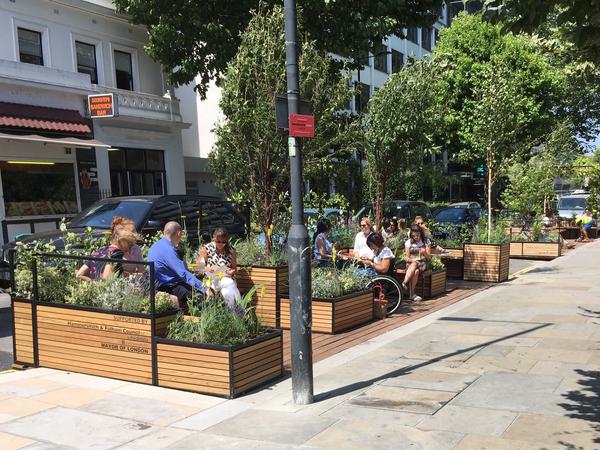
The success of Parklets being able to create and attract activity within streets is another useful precedent, particularly as many have been converted from temporary installations to permanent fixtures following their success. Image source: MeristemDesign.co.uk
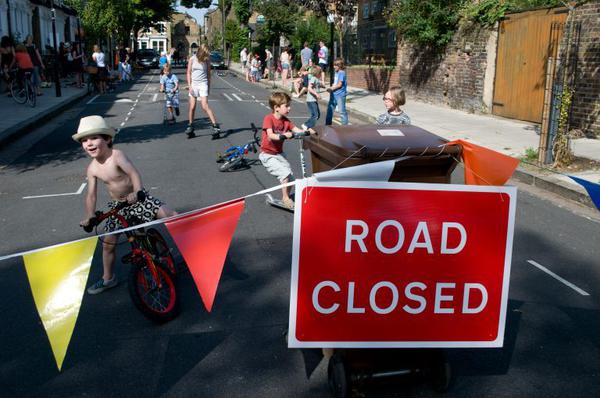
Many play streets have been instigated following initially temporary closures of streets for play and community activities. Image source: Hackneyplay.org
Achieving buy-in from local residents will be an important aspect of being able to implement community super blocks. Temporary closure and installations would be an excellent way of testing and demonstrating anticipated benefits. Each community will have different needs to be met by their dedicated open space, so it would also provide an opportunity to receive feedback to refine the brief. With residents likely to change over time, however, the flexibility of the open space and ability to cater to a wide range of situations should be encouraged.
As we continue to live through the pandemic and various lockdown measures, an increasing amount of people have realised their desire and ability to live in less densely populated areas. However, by being able to increase the amount of quiet, social green space within our immediate vicinity, our neighbourhoods could provide some of the benefits associated with lower density environments, but with the benefits of central urban living.
We hope to take this idea for the community super blocks further, and are aware that there are a number of communities across London who are trying to take similar schemes forward. If you are interested in the idea or would like to collaborate on taking a similar project forward, please don’t hesitate to contact us via the e-mail or social media.
Related Updates
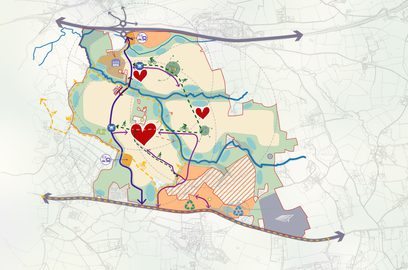
Marlcombe, East Devon selected as one of the New Towns

Tibbalds
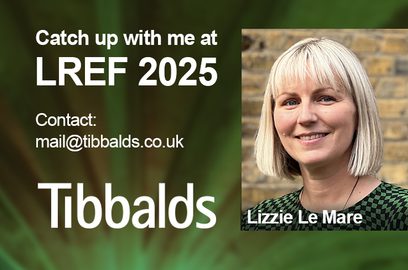
Lizzie Le Mare attending LREF 2025

Tibbalds
Newham Council’s 50% affordable Carpenters Estate regeneration gets underway

Tibbalds
Stay In Touch
Sign up to our Newsletter
Subscribe to our newsletter to receive updates about making people friendly places.